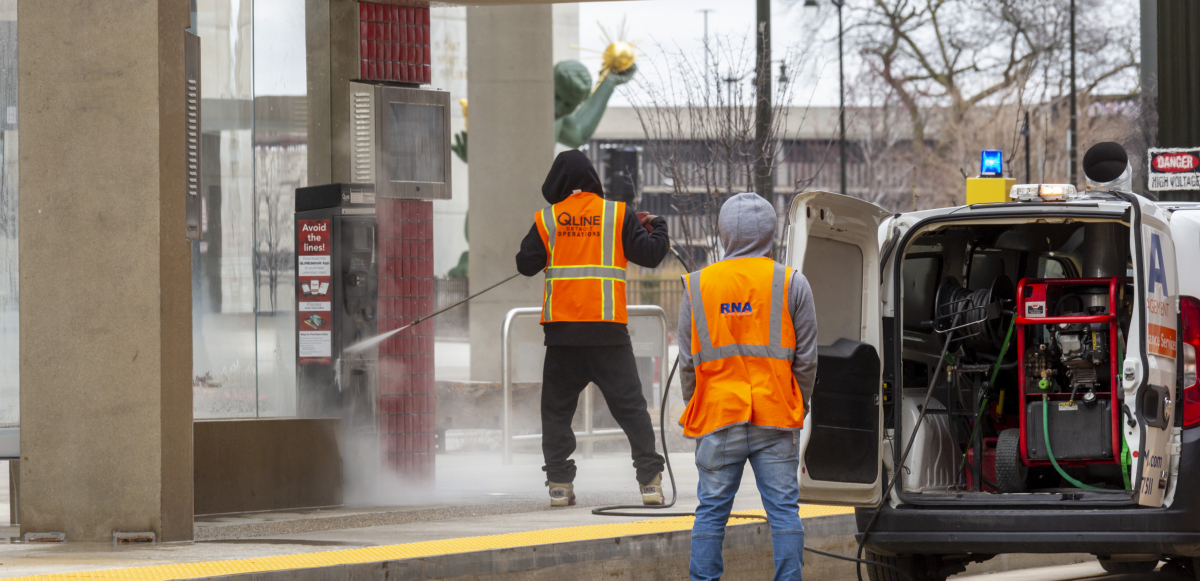The coronavirus pandemic poses serious risks to those workers still on the job, and all too often, management is acting slowly and doing far too little to protect essential employees like grocery workers, UPS drivers, nurses, and Amazon warehouse workers. To defend themselves, their co-workers, and their communities, workers have organized collectively to demand hazard pay, social distancing measures, and personal protective equipment like hand sanitizer and masks.
Below is a list of demands for workplace COVID-19 safety measures and leave policies that workers can adapt for a group petition in their workplaces. It was put together by organizers from the Communications Workers, who have put together a useful website aimed specifically at helping workers without a union organize in response to the coronavirus, "COVID-19 Information for Non-Union Workers." Non-union workers seeking advice can contact CWA organizers through a form at that website, which also includes a helpful overview of workers' right to take action as a group (known as "protected concerted activity") to improve conditions at work.
Download an editable version of the demands below here, or in PDF form here.--Eds.
---
WE DEMAND IMMEDIATE WORKPLACE COVID-19 SAFETY MEASURES AND LEAVE POLICIES
We feel at risk. We have urgent, shared concerns that the current COVID safety protocols in our workplace are not enough. We are asking for immediate measures to address both safety and leave policies, including the following (check those which apply):
- Perform routine environmental cleaning and disinfection. Routinely clean and disinfect all frequently touched surfaces in the workplace, such as workstations, telephones, doorknobs, etc.
- Provision of needed occupational safety and health supplies (circle those that apply):
- Sanitary facilities for handwashing
- Hand sanitizer and disposable disinfecting wipes
- Personal Protective Equipment (PPE): face shields, gloves, goggles, glasses, shoe covers, gowns, head covers, masks, respirators, other as noted ___________________.
- Actively encourage sick employees to stay home and not to return to work until the CDC criteria to discontinue home isolation are met.
- Make provisions for employees at higher risk for serious illness such as older adults or those with chronic medical conditions. Minimize face-to-face contact between higher risk employees or assign work tasks that allow them to maintain a distance of six feet from other workers, customers and visitors, or to telework if possible.
- Inform employees of our possible exposure to COVID-19 if a fellow employee is confirmed to have COVID-19 infection (while maintaining confidentiality as required by the Americans with Disabilities Act).
- Educate employees about how they can reduce the spread of COVID-19 by social distancing and avoiding using other employees’ phones, desks, offices, or other work tools and equipment, when possible.
- Organize the workplace so employees can practice social distancing by avoiding large gatherings and maintaining distance (approximately 6 feet or 2 meters) from others when possible. Increase physical space between employees and customers (e.g., work from home, spaced entry to the business, drive through, partitions).
- Identify a workplace coordinator who will be responsible for COVID-19 issues and their impact at the workplace and who can work to keep employees safe.
- Implement flexible sick leave and supportive policies and practices. Ensure that sick leave policies are flexible and consistent with public health guidance and that employees are aware of and understand these policies.
- Support employees and workplace safety by providing paid leave which provides the proper incentive for sick or exposed employees to stay home.
- Maintain flexible policies that permit employees to stay home to care for a sick or immune compromised family member or take care of children due to school and childcare closures. Use non-punitive emergency sick leave policies.
- Do not require a positive COVID-19 test result or a healthcare provider’s note for employees who are sick to validate their illness, qualify for sick leave, or to return to work. Healthcare provider offices and medical facilities may be extremely busy and not able to provide such documentation in a timely manner.
- Support respiratory etiquette and hand hygiene for employees, customers, and visitors.
- Provide tissues and no-touch disposal receptacles near hand washing locations.
- Provide soap and water in the workplace. If soap and water are not readily available, obtain alcohol-based hand sanitizer that is at least 60 percent alcohol. Ensure that adequate supplies are maintained. Place hand sanitizers in multiple locations to encourage hand hygiene. Place posters that encourage handwashing and discourage handshaking.
- Perform enhanced cleaning and disinfection after persons confirmed or suspected (since confirmation is not always possible) to have COVID-19 have been in the facility.
- Minimize travel.
- Incentivize sick employees to stay home with paid leave.
- Accommodate employees with family care responsibilities (school children at home, family member with COVID) with paid leave and educate workers on FMLA and other benefits.
- Provide hazard pay for essential employees. (Hazard pay provisions that workers have won range from a 10 percent raise to a $2 an hour bonus to a $300 a week bonus.)
- Implement additional needed measures such as _________________________.
Sources:
Centers for Disease Control (CDC) Interim Recommendations for Employers
Occupational Safety and Health Administration (OSHA) Guidance on Preparing Workplaces for COVID-19






